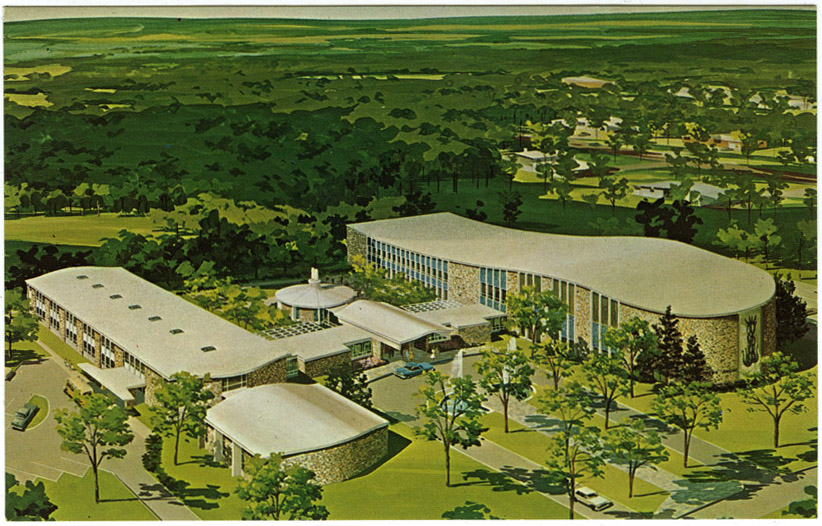10.5 Pikesville (Baltimore), Maryland
Chizuk Amuno Congregation, 8100 Stevenson Road
Daniel Schwartzman, architect , 1957
David E. Traub, Baltimore, Maryland, publisher (both postcards); no date (both postcards)
The suburban synagogue complex of Chizuk Amuno (Strengthening of Faith) is the first for a Baltimore congregation located outside the city limits. The establishment of this new center followed the move of Baltimore Hebrew Congregation a few years earlier. The plan here, designed by prominent Jewish architect Daniel Schwartzman, reflects the expressive style of Erich Mendelsohn more than the style of Baltimore Hebrew’s Percival Goodman. Mendelsohn liked curves, and Goodman preferred sharp angles. Schwartzman’s design is notable for the many curved walls and smooth transitions. It also moves away from the idea of a tightly formed block of buildings around a central core.
Perhaps because so much land was available (72 acres), the six buildings were allowed to spread out, dominated by two great quasi-independent structures connected by a small central entrance pavilion. On one side is the great sanctuary; on the other, the educational wing. The entire complex is set in a lush green landscape. The building’s primary facade faces Stevenson Road and is dominated by a striking curvilinear wall and undulating roofline. The massing is austere, but with rhythmic distribution of windows and tiles.

The complex, located just north of Interstate 695, the Baltimore Beltway, exemplifies many of the functions of the suburban synagogue center, combining worship, administration, community activities, and education. Since more and more congregants now lived in detached houses in sprawling residential developments that were organized more by age (young) rather than religion, the multifunctional synagogue complex became a de facto Jewish village. The new suburbs were for whites only but were diverse in terms of ethnicity and religion. For the post–World War II Jewish generations, the suburban synagogue center was the one place in congregants’ lives where they could immerse themselves in a Jewish environment and partake of a full range of Jewish services—social, educational, religious, and cultural. Formerly, in the more dense and traditional Jewish neighborhoods of Baltimore (and other cities), these offerings were available through multiple providers. Chizuk Amuno was not just a religious center. There was an art gallery, too, reputedly the first located in a synagogue in the United States.
The Chizuk Amuno complex, along with a significant group of contemporary synagogues in the northwest Baltimore suburbs, including Baltimore Hebrew and Oheb Shalom, represent the new Jewish suburban identity. These large complexes, all built with the involvement of prominent Jewish architects, placed Baltimore at the forefront of modernist expression in synagogue architecture in the decades following World War II.
